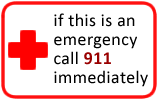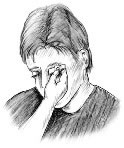Eye Injury
Eye Injury
Does this describe your symptoms? |
Click image for more info |
Definition
General Information
|
If not, see these topics
First Aid:FIRST AID Advice for Bleeding:
FIRST AID Advice for Penetrating Object: If penetrating object still in place, don't remove it (Reason: removal could cause bleeding or more damage). FIRST AID Advice for Shock: Lie down with feet elevated. |
When to Call Your Doctor |
Call 911 Now (you may need an ambulance) If |
|
|
|
Call Your Doctor Now (night or day) If |
|
|
|
Call Your Doctor Within 24 Hours (between 9 am and 4 pm) If |
|
|
|
Call Your Doctor During Weekday Office Hours If |
|
|
|
Self Care at Home If |
|
|
HOME CARE ADVICE FOR MINOR INJURIES OF THE EYE |
Treatment of Superficial Cuts and Scrapes (abrasions) to Eyelid or Area around Eye:
Apply direct pressure with a sterile gauze or clean cloth for 10 minutes to stop any bleeding.
Wash the wound with soap and water for 5 minutes (Protect the eye with a clean cloth).
Apply an antibiotic ointment. Cover large scrapes with a Band-Aid or dressing. Change daily.
Treatment of Swelling or Bruise with Intact Skin:
Apply an ice pack to the area for 20 minutes each hour for 4 consecutive hours.
48 hours after the injury, use local heat for 10 minutes 3 times each day to help reabsorb the blood.
Treatment of Subconjunctival Hemorrhage (flame-shaped bruise of the white area of eyeball): No specific treatment is required. It usually goes away in 2-3 weeks.
Pain Medicines:
For pain relief, take acetaminophen, ibuprofen, or naproxen.
Acetaminophen (e.g., Tylenol):
Take 650 mg by mouth every 4-6 hours. Each Regular Strength Tylenol pill has 325 mg of acetaminophen.
Another choice is to take 1,000 mg every 8 hours. Each Extra Strength Tylenol pill has 500 mg of acetaminophen.
The most you should take each day is 3,000 mg.
Ibuprofen (e.g., Motrin, Advil):
Take 400 mg by mouth every 6 hours.
Another choice is to take 600 mg by mouth every 8 hours.
Use the lowest amount that makes your pain feel better.
Naproxen (e.g., Aleve):
Take 250-500 mg by mouth every 12 hours.
Use the lowest amount that makes your pain feel better.
Extra Notes:
Acetaminophen is thought to be safer than ibuprofen or naproxen in people over 65 years old. Acetaminophen is in many OTC and prescription medicines. It might be in more than one medicine that you are taking. You need to be careful and not take an overdose. An acetaminophen overdose can hurt the liver.
Caution: Do not take acetaminophen if you have liver disease.
Caution: Do not take ibuprofen or naproxen if you have stomach problems, kidney disease, are pregnant, or have been told by your doctor to avoid this type of medicine. Do not take ibuprofen or naproxen for more than 7 days without consulting your doctor.
Before taking any medicine, read all the instructions on the package
Call Your Doctor If:
Pain becomes severe
Pain does not improve after 3 days
Changes in vision
You become worse
And remember, contact your doctor if you develop any of the "Call Your Doctor" symptoms.
Updated:
March 22, 2017




